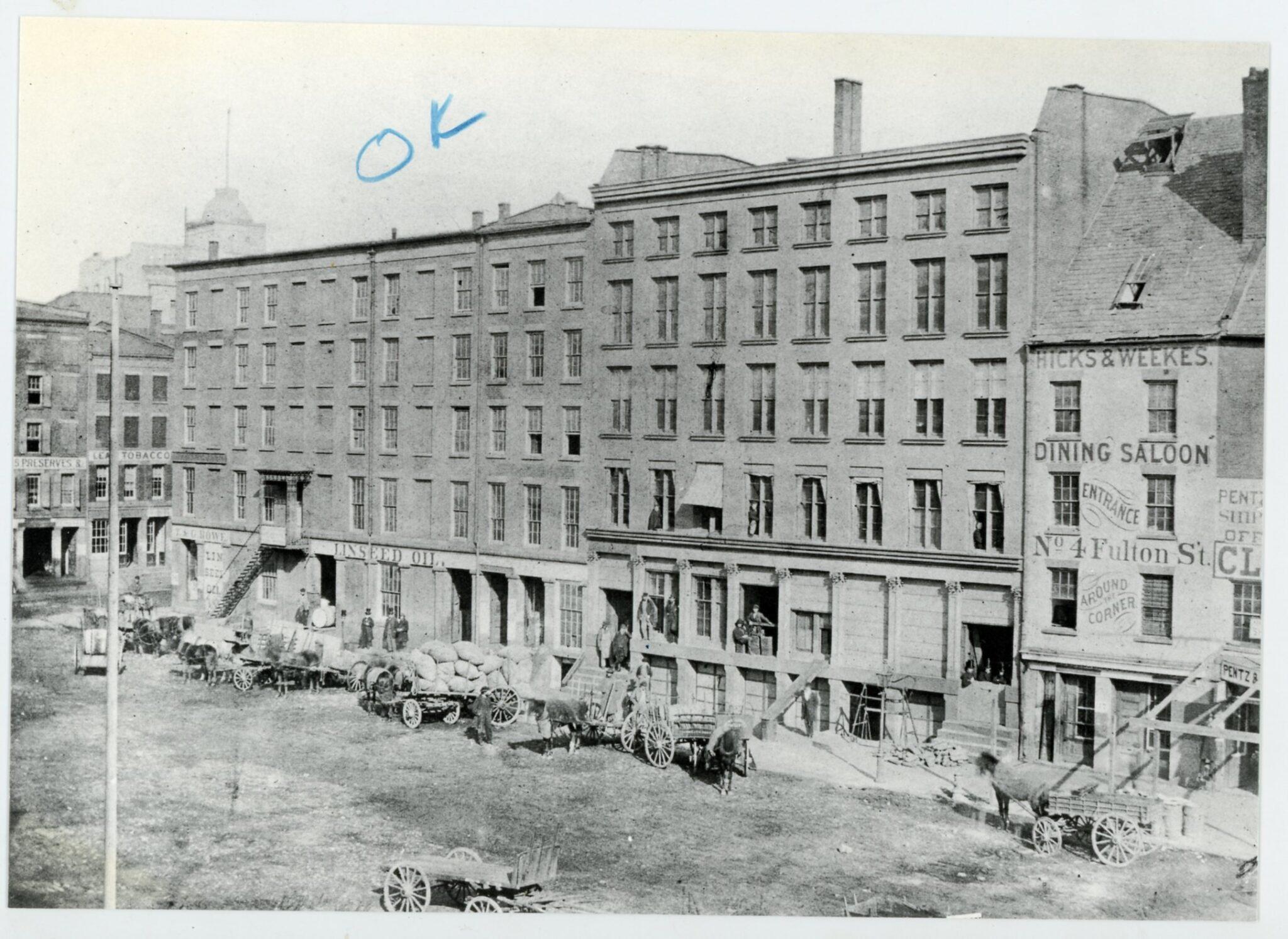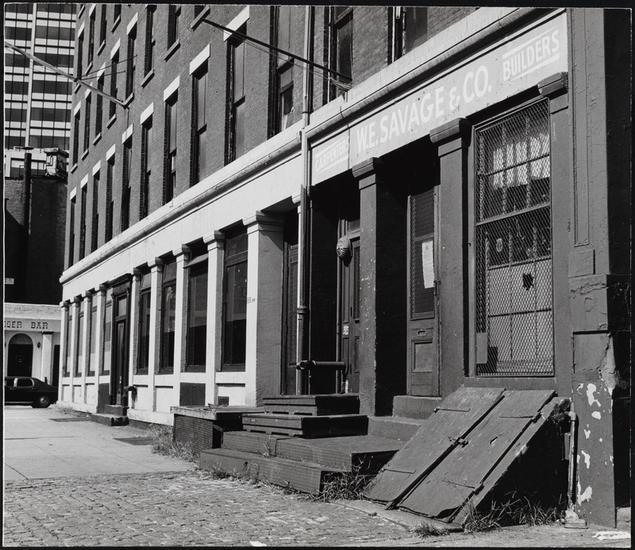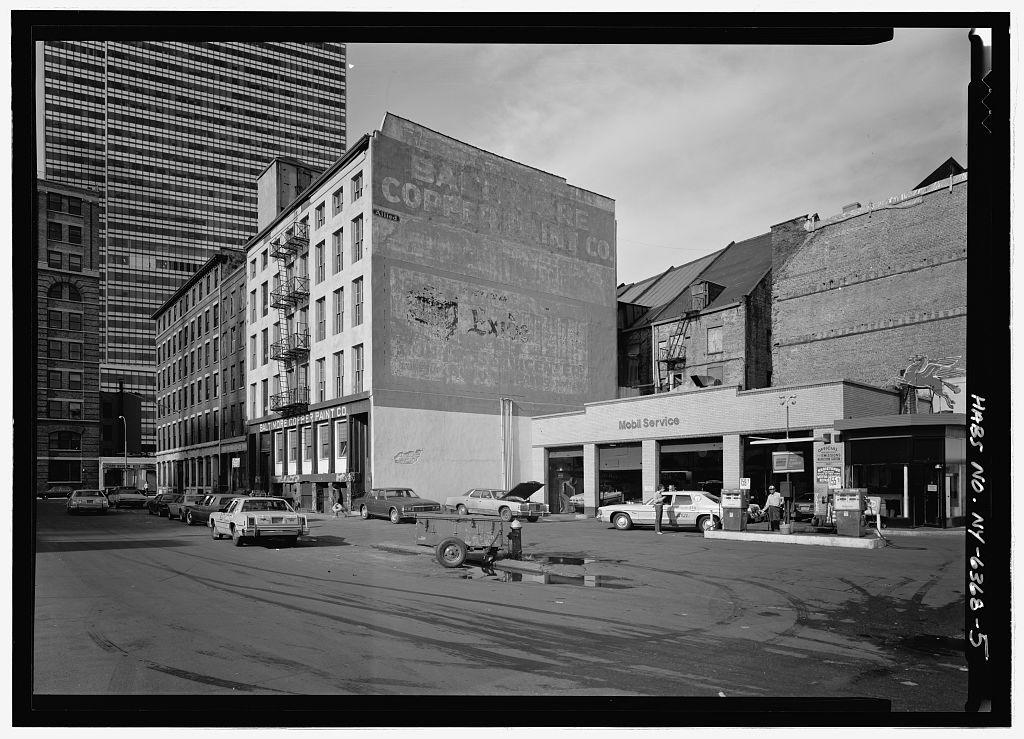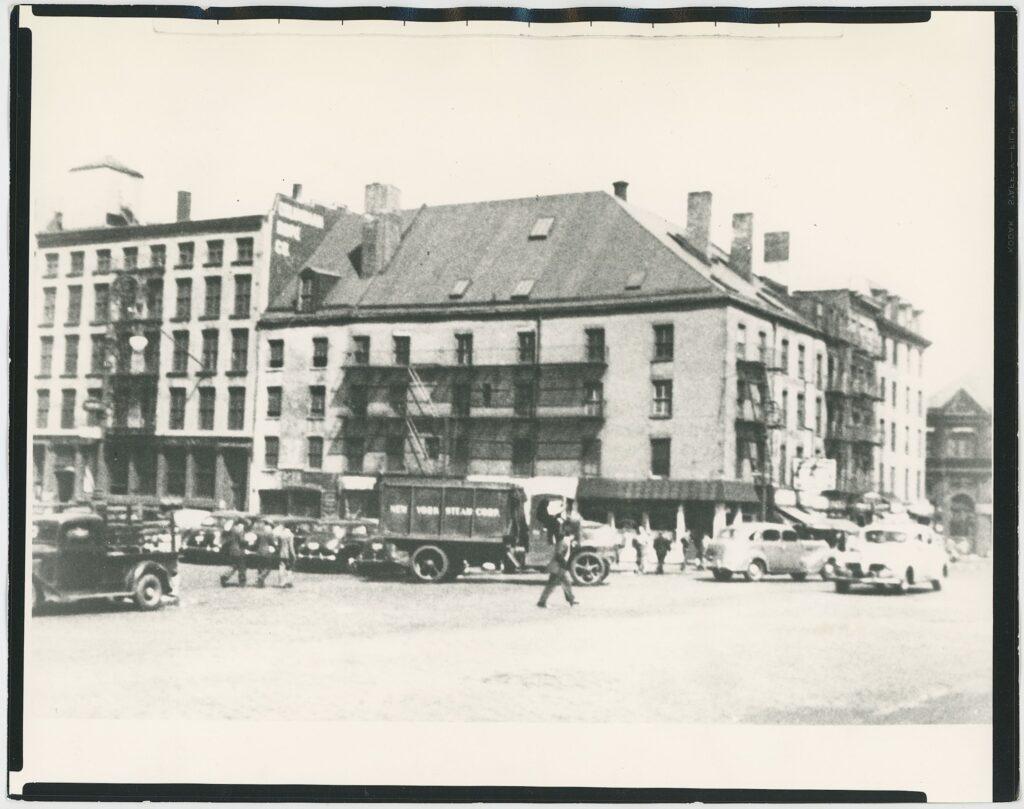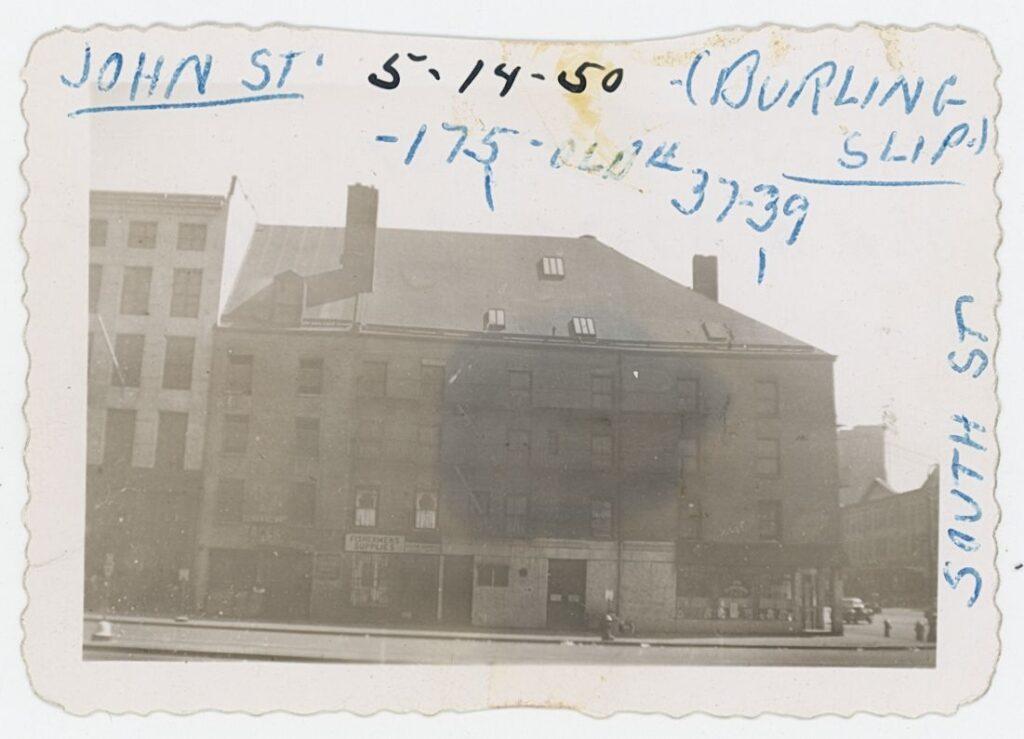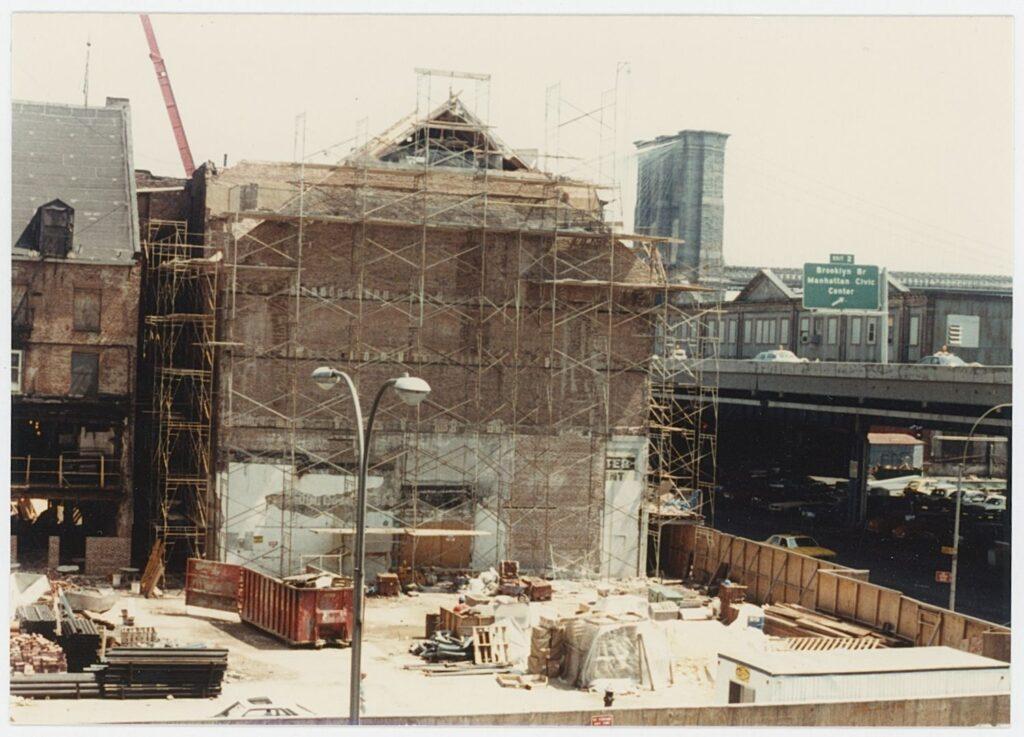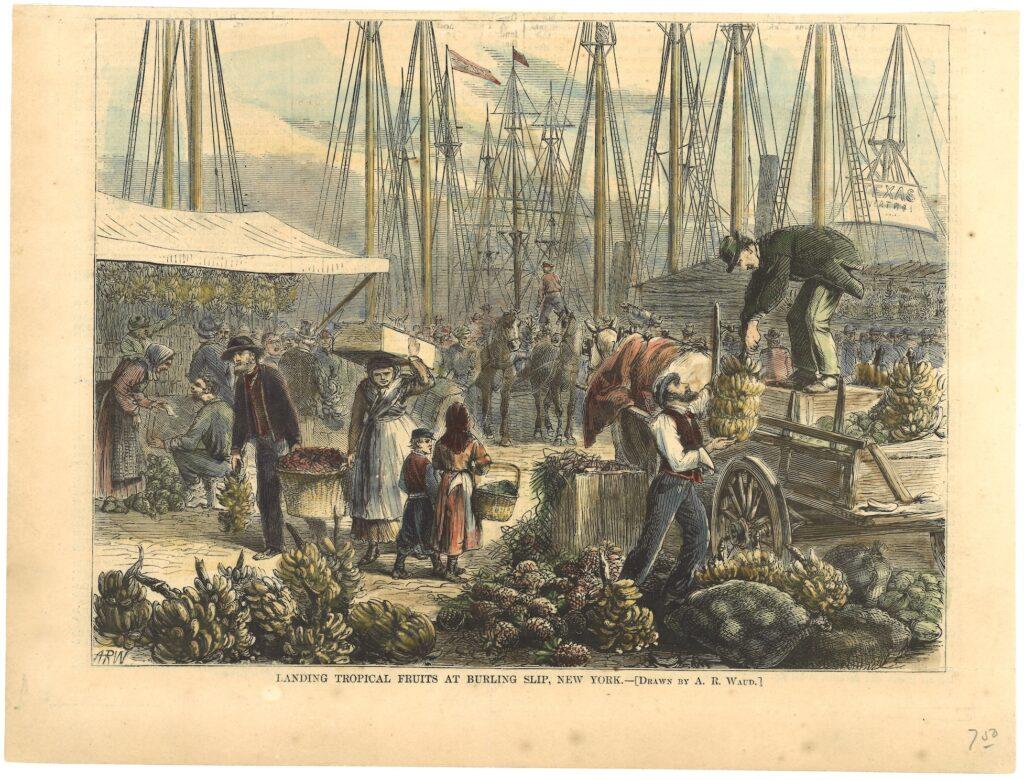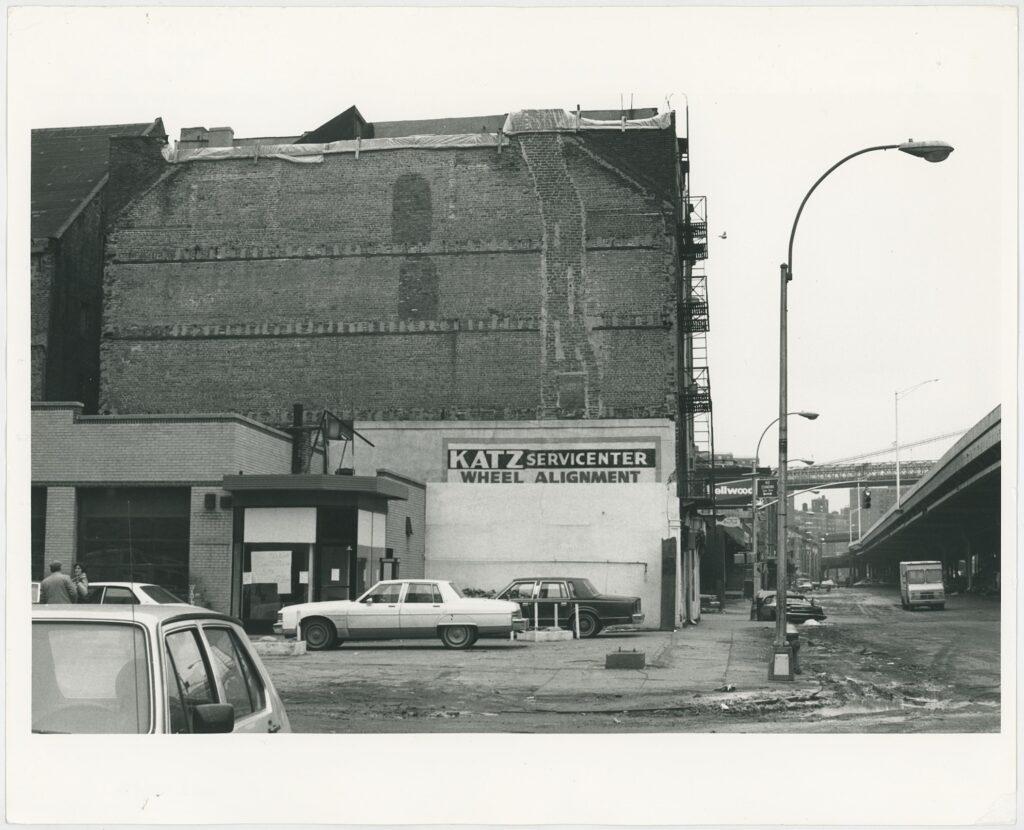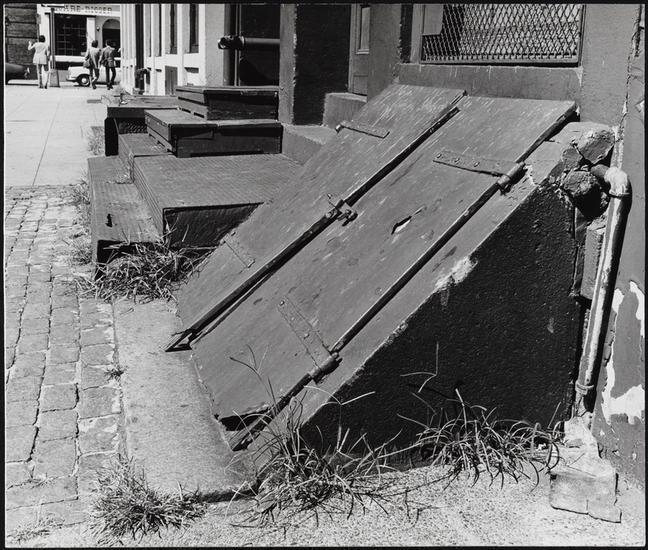167–171 John Street
This brownstone-faced building marked the success of A.A. Low & Brother, which was the most successful merchant in the 19th century trade between New York and China. Importing high-value goods including teas, silks, and porcelain, Abiel Abbot Low’s (1811–1893) fleet of clipper ships were some of the fastest in the trade. The building’s tall basement allowed for easy movement of merchandise, while the raised first floor is notable for its cast iron façade manufactured by the well-known Architectural Ironworks of Daniel D. Badger (1806–1884).
Today, the South Street Seaport Museum occupies these buildings with its administrative offices, collections storage, and archives. In-person access to collections and archives is granted on a case-by-case basis at the discretion of the Director of Collections and Exhibitions. Learn more about the Museum’s Research Policies and Image Services.
Burling Slip
This masonry, cast-iron, and timber-framed building was constructed in 1850 for the A.A. Low & Brothers. Prior to this structure, five identical buildings belonging to merchant George Codwise, Jr. (1732–1814) occupied the same lot, facing the adjacent Burling Slip[1]Slips (or docking basins) are the areas between wharves, which provide a place for ships to load and unload cargo. Burling Slip, located at the terminus of John Street, was known for periods as Lyons … Continue reading.
Known as 29, 31, 33, 35, and 37 Burling Slip, these buildings were immediately rented to a number of merchants and grocers, as coastal trading vessels centered their business at the adjacent slip. One of the merchants was Benjamin Blossom, Jr. (1753–1837), a commission merchant that moved his business from one building to another between 1812 and 1823. In 1821, he was advertising for “…a good vessel…to proceed immediately to a southern port.”
The now-Landmarked building reflects the predominant Greek Revival style of the time in the forms used in the ground-floor trabeated storefronts and in its masonry work.
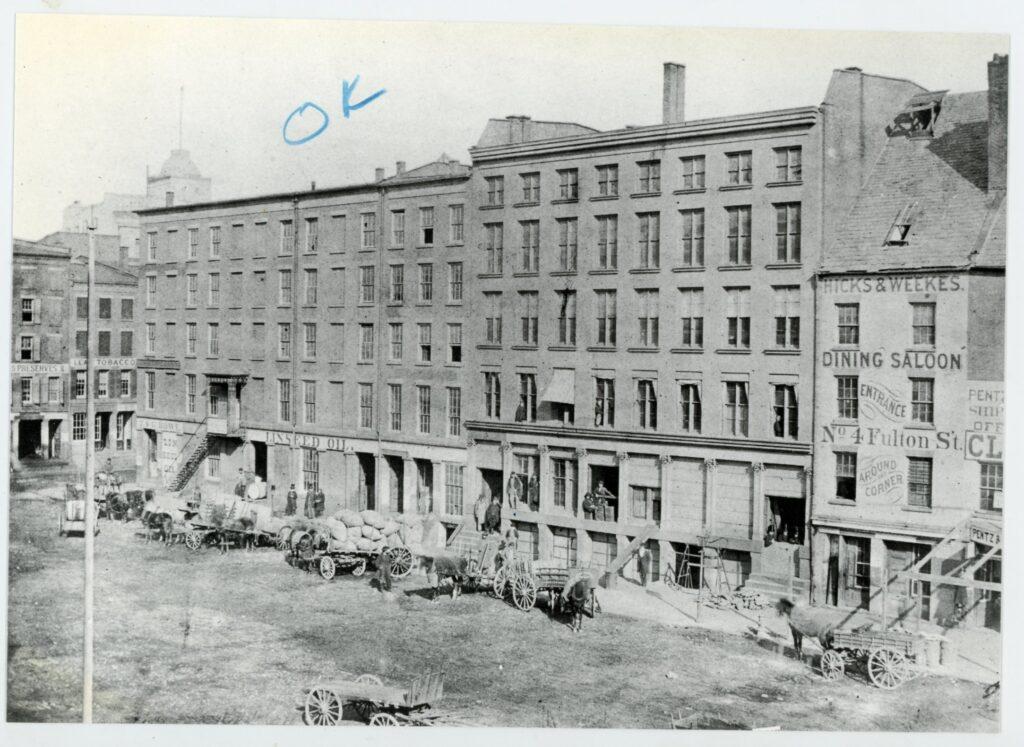
“Burling Slip warehouses” n.d. (original ca. 1880s). South Street Seaport Museum Photo Archive, H102-0582
Typically, Greek Revival buildings are characterized by a granite post-and-lintel frame resting on a granite sill running the entire width of the building, slightly above street level and supported by a brick wall. The concentration of granite at ground level highlights new utilitarian innovations, such as cellars with street access (with related modified entrances and sidewalks) and more access to light and ventilation compared to Schermerhorn Row.
The façade of the building was altered and restored in 1983, but the cast-iron double storefront is original and notable because it was produced by Daniel D. Badger (1806–1884) of the renowned Architectural Iron Works firm[2]The New York Times defined Badger, in his obituary of November 19, 1884 as “the pioneer of this country in the use of iron for building purposes”. According to the same obituary he experimented … Continue reading.
No known change happened to these five structures until 1840, when 29 Burling Slip was raised to five stories and its façade and window placement were also altered. When A.A. Low bought 31, 33 and 35 Burling Slip in 1849, they too were about to be greatly altered. Only 37 Burling Slip survived virtually unchanged into the 20th century, enabling us to visualize the appearance of the original blockfront.
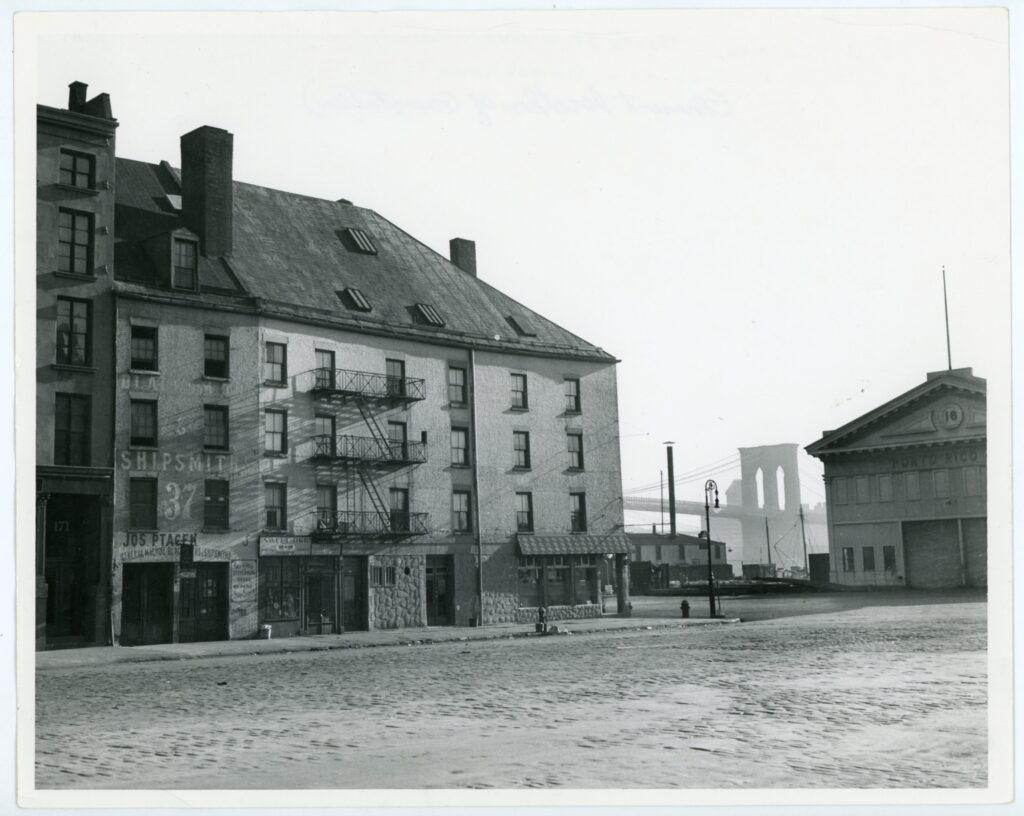
[Buildings at the northwest corner of John Street and South Street] n.d. (original 1936). South Street Seaport Museum Photo Archive, H102-0591
A.A. Low & Brothers
Founded by Abiel Abbot Low (1811–1893), A.A. Low & Brothers was New York’s most successful firm in the China trade importing cinnamon, pepper, silks, porcelain, firecrackers, and tea.
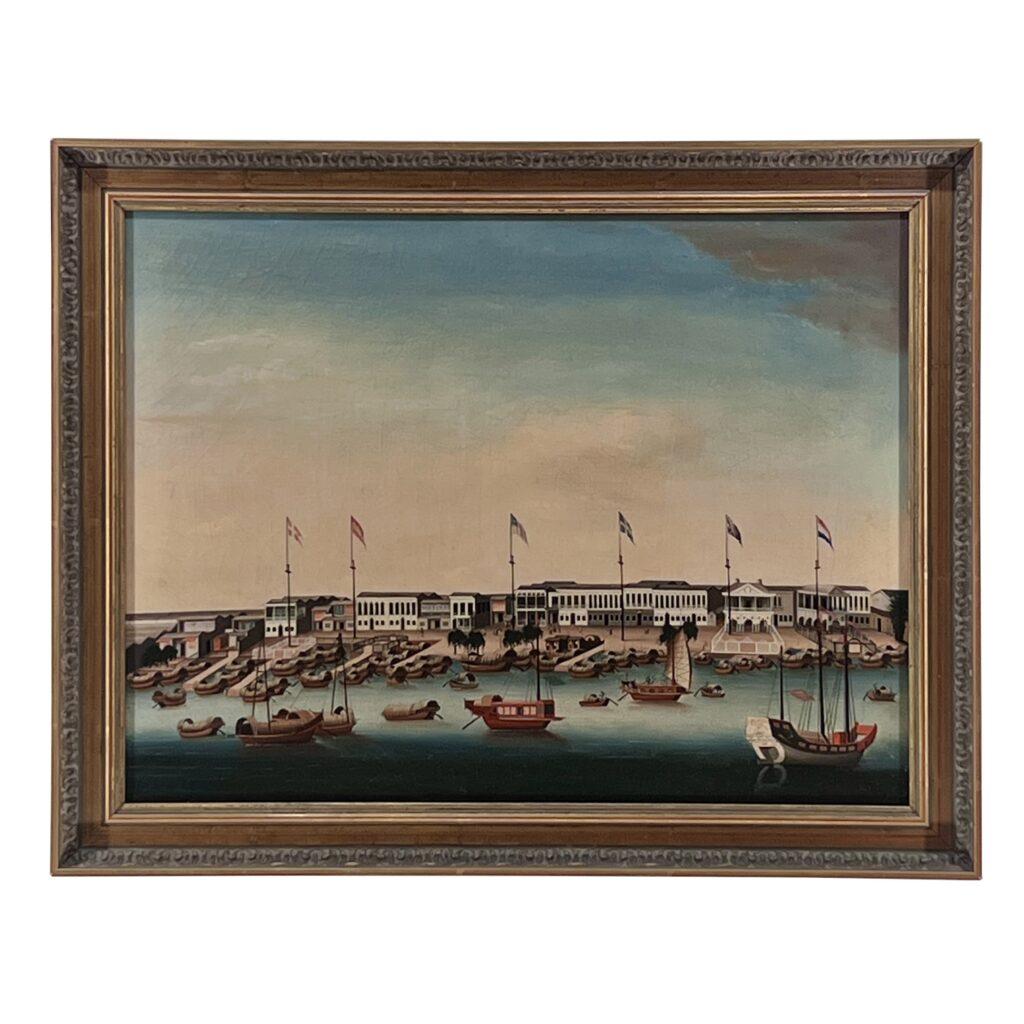
Originally from Salem, Massachusetts, Low spent seven years in China as a clerk at the American firm of Russell & Co. in Canton (Guangzhou), where his uncle, William, was a partner. There, he learned how the market prices in China and New York were connected, and how the speed of ships affected those prices.
He also became friends with one of the legendary Cantonese merchants Wu Bingjian (1769–1843), also known as Houqua, and Low’s success in the China trade was greatly owed to this connection.
“Canton Factories” mid-19th century. Peter A. and Jack R. Aron Collection, South Street Seaport Museum Foundation 1991.068.0065
After settling in New York in 1840, Low used the money he made in China to build a fleet of fast clipper ships. With his previous experience in China and his network of suppliers, Low knew how to get Chinese goods for the best price; and his high-speed ships were beating his competitors and earning him large profits.
In 1867, A.A. Low embarked on a grand circumnavigation of the Earth—after which he was celebrated by New York’s high society and the New York Chamber of Commerce, for which he once served as President. From his great success in China Trade ventures, Abiel A. Low became a financier of the Transatlantic Cable, American railroads, and Columbia University in New York City.
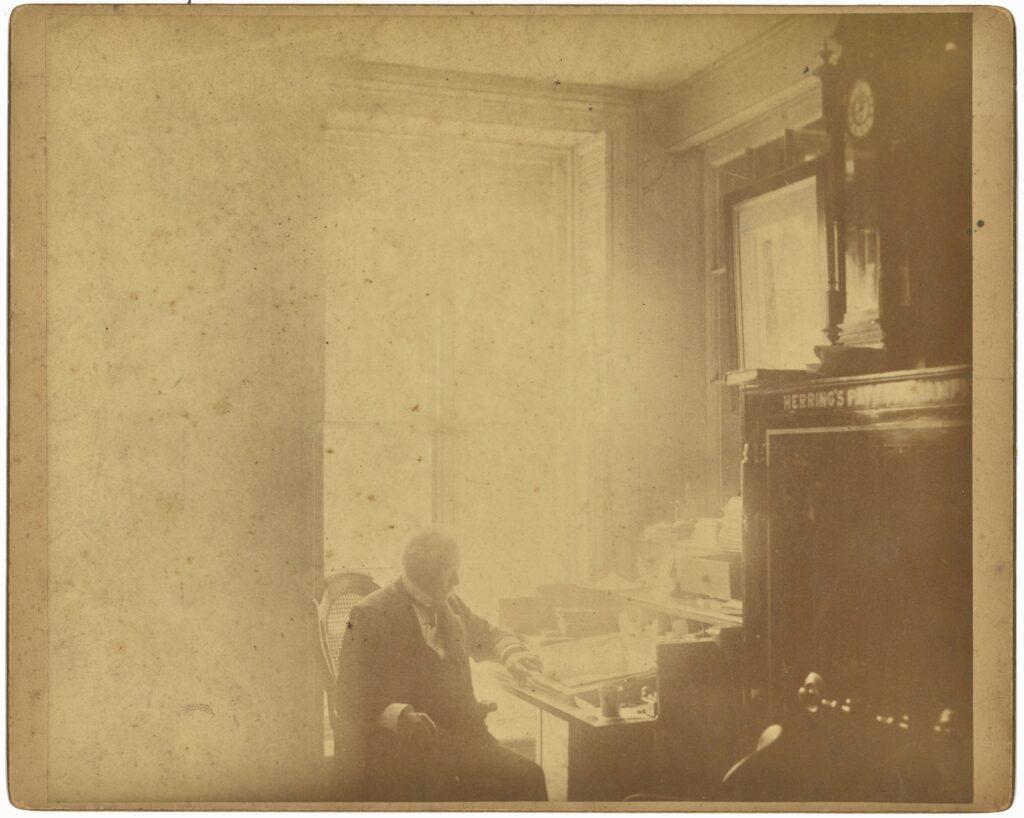
A.A. Low & Brothers was located at 31 and 33 Burling Slip using the buildings both for offices and as warehouses where, on Saturday mornings, A.A. Low’s children were taken for a visit “to sniff the delightful odors of teas, cinnamon and firecrackers.”
“Abiel Abbot Low at his desk” ca. 1860-1890. Gift of Mr and Mrs Geoffrey R.T. Kenyon, 2003.041.0003
35 Burling Slip was rented out, and records show that as early as 1853 Low received rent from the Delano family, merchants active at the address between 1850 and 1856. The Delano family, particularly Warren Delano Jr. (1809–1898), President Franklin D. Roosevelt’s grandfather, was deeply involved in the China trade, specifically in the opium trade. The United States’ involvement with the 19th century opium trade was on a far smaller scale than that of Britain, where opium was the prime mover behind the global drug traffic, and where the single largest, and richest, group of “private traders” involved in smuggling opium into China operated[3]Long before the Sacklers appeared on the scene, families like the Astors, the Peabodys, and the Delanos cemented their upper-crust status through the global trade in opium. Learn more about it in The … Continue reading.
In the 1890s–1900s, the Oriental & Occidental Tea Company was associated with 31, 33, and 35 Burling Slip, as these trade cards from the Museum’s collection show. Most records suggest that the O&O Tea Company was founded in 1893, but there trade cards and advertisements are in newspapers dated 1889. The company’s head office and storage was in Manhattan, but their advertisements said this “perfectly pure, most delicious beverage [was available] for sale by all best grocers.”[4]October 17, 1889, Historical Newspaper of North Carolina https://historicnewspapers.sc.edu/lccn/sn93067794/1889-10-17/ed-1/seq-4.pdf
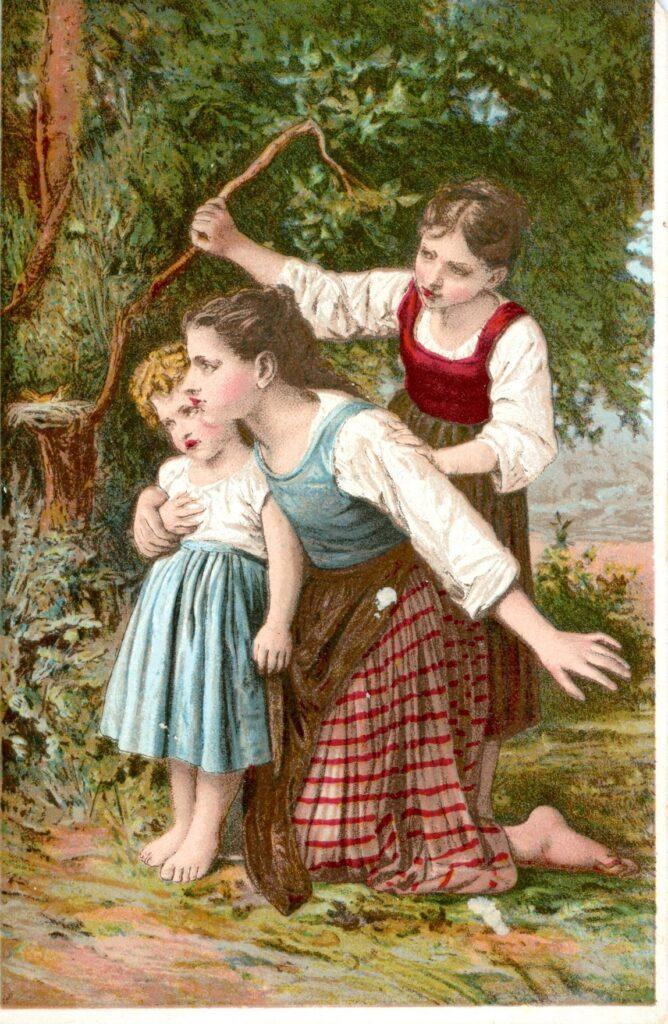
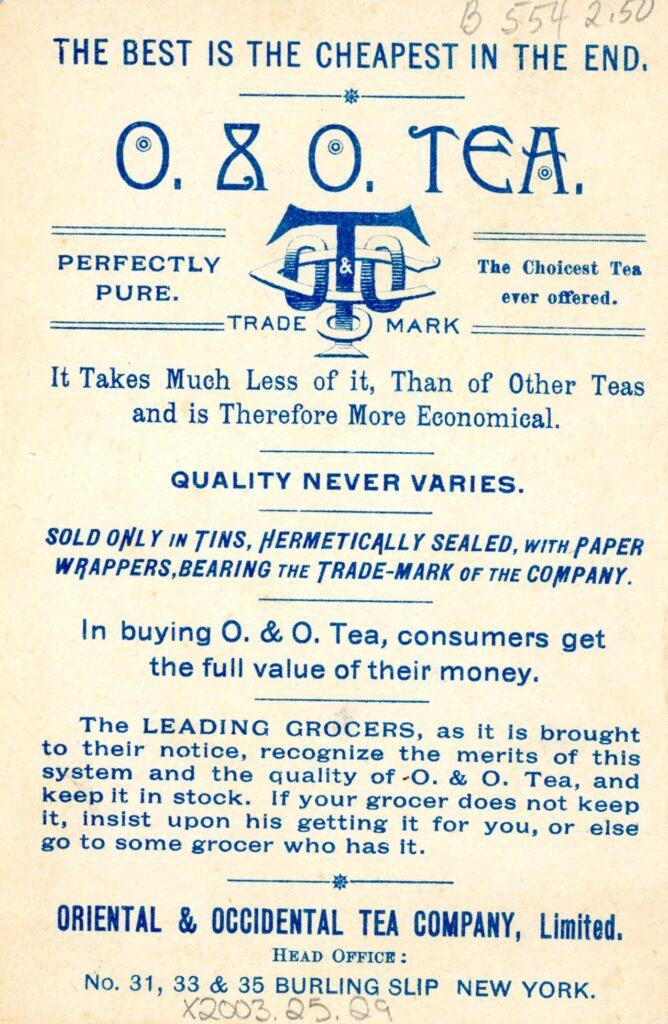
“Oriental & Occidental Tea Co. Trade Card” early 20th century. Trade Card Collection, 2003.025.0029
20th Century Developments
The A.A. Low & Brothers company dissolved around 1890. A.A. Low died in 1893, but various descendants carried on the business at Burling Slip well into the 20th century. In 1916 and 1917, for example, extensive alterations to the buildings were made and documented, including the installation of an Otis elevator.
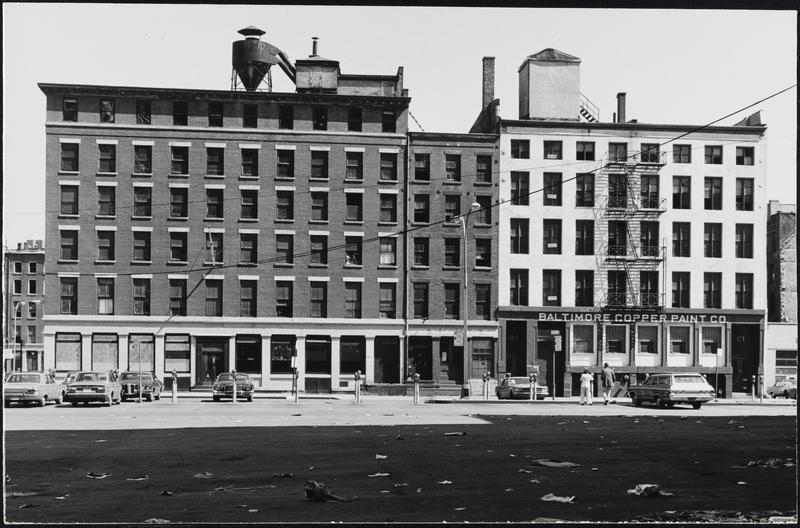
[W.E. Savage & Co., 165 John Street, and Baltimore Copper Paint Co., 167-171 John Street.] ca. 1975. Courtesy of the Museum of the City of New York, 2013.3.1.947
Baltimore Copper Paint Co. occupied the building from 1965 and 1974, using it as offices and storage for marine paints. Founded in 1870 by Oliver Reeder (1844–1904), the company was one of many paint manufacturers in Baltimore, Maryland, at the time. Its namesake “copper paint” inhibited the growth of barnacles on the bottoms of boats sailing in salty waters—a must-have product in a shipbuilding town like Baltimore. The company manufactured vessel coatings for the US Maritime Commission, the US Navy and the British Admiralty, including all of the Liberty ships coming out of Baltimore during World War II.
The building was never used for residential purposes.
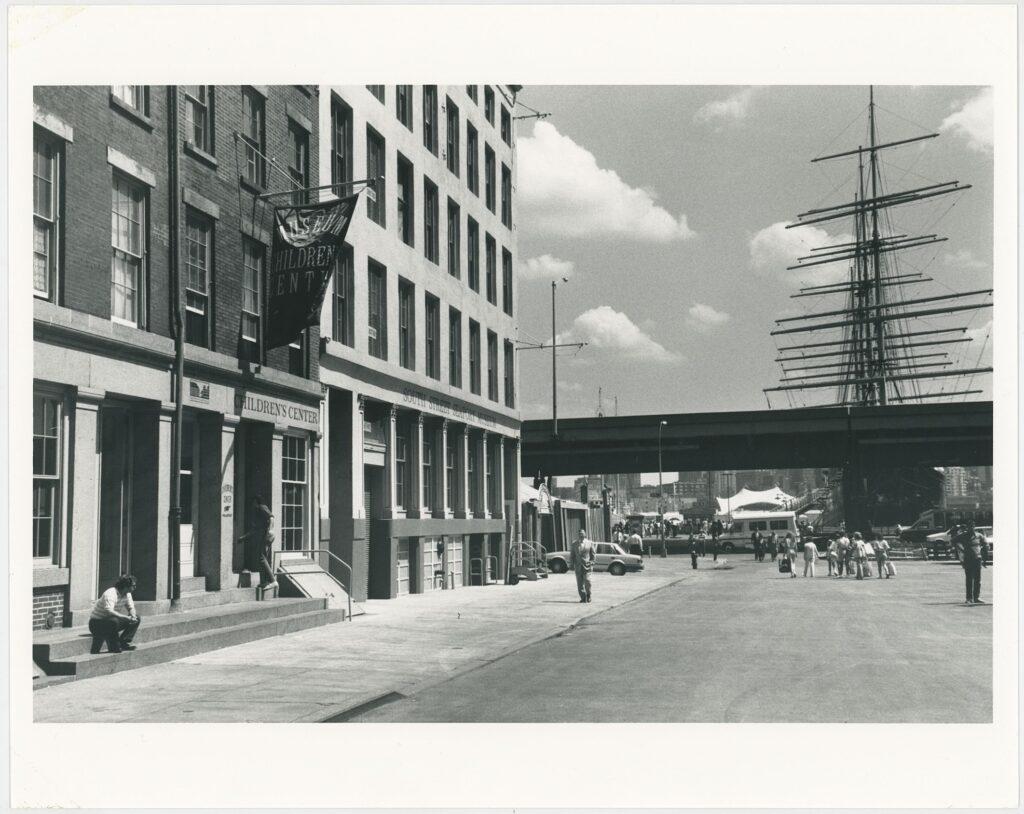
In 1991, Jan Hird Pokorny Associates restored the building and made modifications for adaptive reuse by the South Street Seaport Museum. This included designing a climate-controlled system for Museum exhibitions and storage facilities, conservation laboratories, workshops, and administrative offices.
The project included a complete façade restoration as well as the installation of a new freight elevator and fire stairs. As a whole, the building represents the success and importance of the original builder, and is an important reminder of New York’s seafaring past.
[Restored A.A Low Building on John Street] ca. 1991. South Street Seaport Museum Photo Archive, H102-0590
Today, the building holds the Museum’s administrative office, collections storage and archives, and Burling Slip holds the Imagination Playground. The playground has a fascinating history of its own, as archaeologists and construction workers uncovered the remains of two buried wharves while digging its foundations in May 2009!
The first discovery in the development of the playground was a 190-foot section of Codwise’s Wharf, found along the eastern edge of John Street and originally constructed in stages between 1803 and 1807 by George Codwise Jr.. The corner of a second wharf, Remsen’s Wharf, which was probably constructed about ten years earlier, was discovered near the corner of Burling Slip and Front Street. Learn more about the archaeological discoveries at Burling Slip on the New York City Parks website.
More Views of the A.A. Low Building from the Archives
South Street Seaport Museum
By subway: Take the A, C, 2, 3, J, Z, 4, or 5 train to Fulton Street.
By bus: Take the M-15 SBS or M-15 to Fulton Street.
By water: The NYC Ferry, and New York Waterway provide service to Pier 11. The Staten Island Ferry provides services to Whitehall Terminal.
Parking: Parking lots can be found at Front and John Streets, as well as 294 Pearl Street.
References
| ↑1 | Slips (or docking basins) are the areas between wharves, which provide a place for ships to load and unload cargo. Burling Slip, located at the terminus of John Street, was known for periods as Lyons Slip, Rodman’s Slip, and Van Clyffe Slip. The northernmost portion of Burling Slip was created prior to 1692, when two wharves were constructed on either side of the 24-foot wide docking place on the property of Mrs. Van Clyffe. The Slip was maintained by the City, and by 1730, landfill had occurred there to allow for the construction of Water Street along the inner edge of the Slip.” Burling Slip Bulkhead Documentation, Block 74, Portions of Lots 20 and 1 Borough of Manhattan, New York, New York. Prepared by AKRF, Inc., June 2, 2011. |
|---|---|
| ↑2 | The New York Times defined Badger, in his obituary of November 19, 1884 as “the pioneer of this country in the use of iron for building purposes”. According to the same obituary he experimented as early as 1842 with an iron storefront on the ground floor of a building otherwise of masonry. It was the first in Boston, although the same sort of construction had been employed in New York even earlier, as evidenced by an ad for a brick building ‘with heavy iron columns and lintel and shutters’ that appeared in the New York Commercial Advertiser for August 15th, 1836. “[Badger] went on to great success after he came to New York in 1848. His first small foundry was at 42 Duane Street, diagonally opposite Bogardus’ conspicuous all-iron factory. Badger’s first specialty was iron rolling shutters. He went on to fabricate elements for the increasingly popular iron fronts. By 1854, he had expanded to a site on East 14th Street, between Avenues B and C, where his ever-growing great iron works turned out some of the most dramatic iron buildings this country has ever seen.” |
| ↑3 | Long before the Sacklers appeared on the scene, families like the Astors, the Peabodys, and the Delanos cemented their upper-crust status through the global trade in opium. Learn more about it in The Blue-Blood Families That Made Fortunes in the Opium Trade by Amitav Ghosh. The Nation, January 2024. |
| ↑4 | October 17, 1889, Historical Newspaper of North Carolina https://historicnewspapers.sc.edu/lccn/sn93067794/1889-10-17/ed-1/seq-4.pdf |
